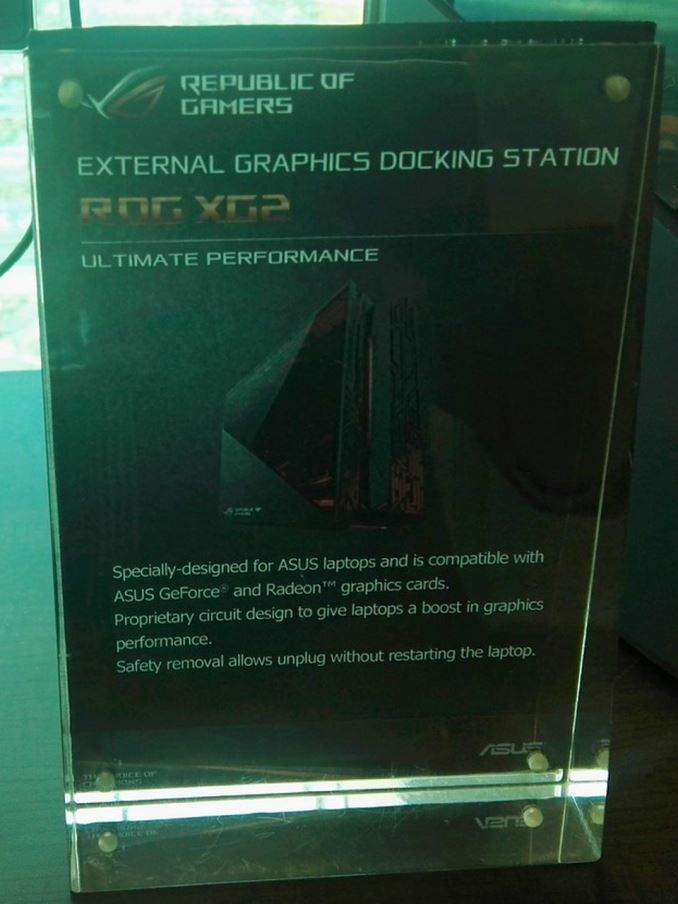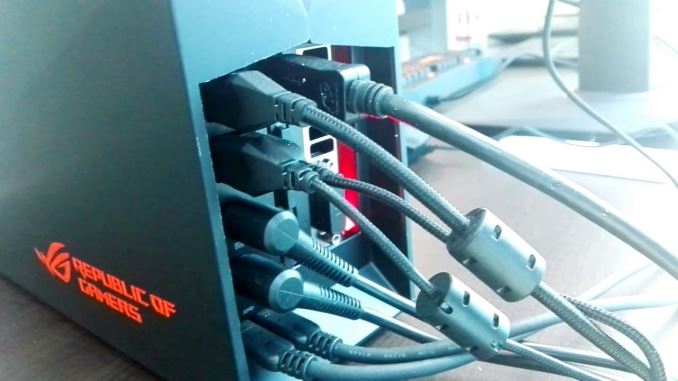ASUS Booth Tour at CES 2016: 10G Switches, External GPU Dock, USB-C Monitor and more
by Ian Cutress on January 19, 2016 9:00 AM ESTDuring CES this year it was clear that one of the overriding themes was external graphics solutions. Intel’s Thunderbolt line of ICs has historically been the source of musings, and we saw first and second generation Thunderbolt enclosures being demonstrated at previous events. Several reasons were given for them not being released, including limited bandwidth and the ability to hot-plug were cited as well as other factors. Third generation Thunderbolt offers up to 40 Gbps of bandwidth over an active cable, and it sounds like some implementations are now supporting hotplug, meaning that we will see some entering the market. However, ASUS’ implementation is considerably different.
The External GPU Dock, over Type-C
If we look at several items on the market, namely the newly announced GX700 laptop from ASUS with a water-cooled graphics card, or the MSI GS30 series of laptops, or even something like the MSI AIO with an external graphics card - the trend is to pass the PCIe lanes through an interface as if the connection is transparent to the PC. This has a variety of limitations such as hot plug probably won’t be enabled and it requires a reboot to switch between the graphics, but it does provide a stop-gap solution for sure.
The external GPU dock on display from ASUS is a little different again to the laptops and AIO mentioned in the previous paragraph, by taking the PCIe lanes and passing the data over a Type-C interface. Using a proprietary IC, ASUS is able to carry 32 Gbps of data over a passive Type-C cable (note, Thunderbolt 3 is limited to 20 Gbps over passive) to a dock that can decode the data. That being said, there were two data cables going from the dock to the laptop, making me think that this is actually two lots of 20Gbps maximum and the IC logic is there to reconstruct the bits from different PCIe lane data streams.
The enclosure on display we are told is near final, and uses the same Mayan pattern-like design as ASUS’ current range of small gaming PCs. The dock is designed to take any serious single GPU card up to 350W, and because the data comes over PCIe, the card can also be overclocked as if it was directly attached as in a normal desktop. Here’s a video:
So there are a few things worth mentioning. The external dock does need an external monitor to run. Because the dock requires ASUS proprietary technology and only ASUS laptops will have it, we are told that the laptops will carry a mini-DisplayPort input connection, meaning that the GPU can be hooked straight back into the laptop if necessary. If the dock has sufficient power, it can also be used to charge the laptop via a USB-C charging connector as well, meaning that the laptop does not need to be attached to power when this is occurring.
External graphics is a minefield of coping with errors. If the dock is removed, the system should crash, but the idea here is that a user can simply bring their laptop home and start doing powerful gaming. ASUS is saying that their solution can survive a hot-plug event, merely by causing the program that needs the GPU to close – but each GPU will need to be validated in this environment separately as time goes on. The other element is that if this ends up purely for ASUS laptops, there needs to be a few models (both gaming and business oriented) that can support it. No doubt we will see more as time goes on.













50 Comments
View All Comments
pixelstuff - Wednesday, January 20, 2016 - link
Or for $530 at Netgear GS728TX-100NES which gives 4 10GB ports and 24 1GB ports.http://www.amazon.com/dp/B00OZCFVVC
thewishy - Thursday, January 21, 2016 - link
The D-Link DGS-1510-28X is even cheaper. This goes with an SFP+ approach rather than copper 10GBaseT - but given the power consumption and latency for 10GBaseT, that's no bad thing.Fibre is cheap, SR SFP+ is cheap. Direct Attach Copper is cheap. As long as you're not trying to reuse existing structured cabling, it's the logical route right now.
nils_ - Sunday, January 24, 2016 - link
SFP+ DA is cheap? I think the last time I had to pay around 60 EUR for a 3m cable...pixelstuff - Wednesday, January 20, 2016 - link
What I am really hoping to see in the near future are 10G ports on all the Mini-ITX boards. I have been trying to make all my new computers builds with Mini-ITX if at all possible (to get a tiny case) and I don't want to give up the graphics card slot for higher networking speeds.nils_ - Tuesday, January 26, 2016 - link
PCIe lanes may still pose a problem there, although with DMI 3.0 there are now more options.azrael- - Thursday, January 21, 2016 - link
No C236 motherboard? ASUS, I am disappoint!06GTOSC - Thursday, January 21, 2016 - link
I don't understand why they don't come out with a standard port that wires to into the PCI-e lanes specifically for external graphics. This way we get standardized enclosures and connections and it will support any GPU. External graphics have been an idea for over a decade. Yet they have not done this.Murloc - Thursday, January 21, 2016 - link
because not enough people need it enough to pay for it.Laptop gamers are a minority, those who aren't happy with laptop performance and know the difference between one video card and another and care enough about performance yet they don't buy a normal tower computer because they don't care about the ergonomics or have to move around THAT often are an even smaller minority.
newcracksoftware - Monday, February 1, 2016 - link
thanks for the one who had created this article.Lieuchikaka - Thursday, June 2, 2016 - link
http://mavangvn.vn/ma-vang-dien-thoai/dien-thoai-s...my phonne